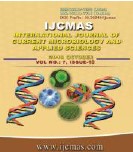


 National Academy of Agricultural Sciences (NAAS)
National Academy of Agricultural Sciences (NAAS)

|
PRINT ISSN : 2319-7692
Online ISSN : 2319-7706 Issues : 12 per year Publisher : Excellent Publishers Email : editorijcmas@gmail.com / submit@ijcmas.com Editor-in-chief: Dr.M.Prakash Index Copernicus ICV 2018: 95.39 NAAS RATING 2020: 5.38 |
Chronic suppurative otitis media (CSOM) is a persistent, insidious and potentially dangerous disease because of its various fatal complications. It is still a significant health problem in developing countries. It is the common cause of conductive deafness. Change in the bacteriological scenario with indiscriminate use of antimicrobial agents has been associated with the emergence of multiple drug resistant strains. Information regarding the common pathogens and their antibiotic sensitivities is essential for the proper choice of antibiotics. Hence the present study is undertaken to know the aerobic bacteriological flora of CSOM and their antibiogram. One hundred and nine clinically diagnosed cases of CSOM of all age groups and both the sexes attending ENT OPD and admitted in ENT wards were studied. Ear swab was taken from each patient, further subjected to Gram staining and culture onto blood agar, MacConkey's agar and Chocolate agar. The bacterial isolates were identified by standard biochemical reactions. Antibiotic susceptibility testing was done by Kirby-Bauer disc diffusion method. A random selection of 109 CSOM cases was studied, of which 71 were males and 38 were females. Majority of the patients were in the age group of 11 to 20 years. Predominance of Pseudomonas aeruginosa (53.91%) followed by Staphylococcus aureus (28.69%), Proteus mirabilis (6.09%), Klebsiella pneumoniae (5.23%), Citrobacter freundii (4.35%) and Escherichia coli (1.73%). Antibiotics like Imipenem, Piperacillin-tazobactum, Amikacin, ciprofloxacin and Levofloxacin were found to be more effective against all Gram positive and Gram negative isolates. Pseudomonas aeruginosa was the predominant organism followed by Staphylococcus aureus, Proteus mirabilis, Klebsiella pneumoniae, Citrobacter freundii and E. coli. The most effective drugs were Imipenem, Piperacillin-tazobactum, Amikacin, ciprofloxacin and Levofloxacin.
 |
 |
 |
 |
 |